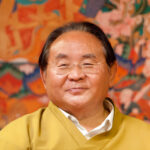Welcome to our online suggested practise for the week number 75. We are now broadcasting a live teaching each Monday evening. If you would like to participate please contact us using the contact form on the homepage.
1.0) If you feel so inclined, begin by reciting the usual prayers (please follow below links for text). Alternatively, try to think or articulate a wish for all beings to achieve liberation from suffering, etc .
Four Thoughts: contemplating each in turn – http://northantsbuddhists.com/the-four-thoughts/
Refuge Prayer: twice in Tibetan, once in English – http://northantsbuddhists.com/the-refuge-prayer/

2.0) Meditation Advice A reading from Lama Sogyal Rinpoche – Presented by William Duncan

In Karma Yeshe’ teaching on the 30th August, he recommended the daily practice of Meditation, Mindfulness and Reflection. Tonight’s reading follows on from that teaching.
The reading is from Lama Sogyal Rinpoche who was one of the great Masters of the Tibetan Buddhist tradition, and the founder of the international Buddhist network Rigpa. He died about two years ago but will be best remembered as the author of the acclaimed “Tibetan Book of Living and Dying
Sogyal Rinpoche shared a simple mediation method through which we can release and relax the mind. The reading is as follows:
“It is said that, in meditation, we should neither follow the past nor anticipate the future but just leave our minds in the clear awareness of nowness. When thoughts come, we do not try to suppress or block them but neither do we have to follow after or indulge them. By just remaining present and undistracted, our thoughts and thinking all settle; like clouds dissolving, revealing a clear sky.
When thoughts and emotions settle like this, in the state of calm abiding, and you are able to remain in the state of non-distraction, then clear seeing, clarity or insight is possible.
The Essence of Meditation:
Amidst the tremendous uncertainty of our lives, we all need to find a way to overcome the difficulties we encounter and so discover the peace of mind, stability and happiness that we need to face the challenges of the world today.
Happiness depends entirely upon our mind and how it perceives, so it is vital to take care of our mind. If we do not want suffering, then we must abandon the harmful actions that are the cause of suffering. And if we want happiness, then we must cultivate the wisdom and positive emotions and actions that are the causes of happiness. Most importantly, we need to understand and transform our mind. The method for realizing the nature of mind is meditation. First, we allow all thoughts and emotions to settle. From this deep peace dawns the clear insight of wisdom that can reveal the nature of reality.
What Meditation really is
Meditation has many stages or levels, but the true purpose and highest goal of meditation is: to awaken in us the sky-like nature of mind, and to introduce us to that which we really are, our unchanging pure awareness, which underlies the whole of life and death.
Generally, we spend our lives distracted from our true selves, in endless activity. We are fragmented into so many different aspects that we no longer know who we really are, or what aspects of ourselves we should identify with or believe in. So many contradictory voices, dictates, and feelings fight for control over our inner lives that we find ourselves scattered everywhere, in all directions, leaving nobody at home.
Meditation, then, is bringing the mind home.
Through meditation our mind begins to settle, and as it does, something extraordinary takes place: all the fragmented aspects of ourselves come home, and we become whole. Negativity and aggression, pain, suffering, and frustration are actually defused. We experience a feeling of peace, space, and freedom, and out of this settling comes a profound stillness.
As we progress further and come into touch with our true nature, it disarms and dissolves our ordinary thoughts and emotions. As this happens, tremendous love and compassion begin to shine through us, just like the sun with all its warmth. We find we are not only in touch with ourselves, but completely in touch with others also. As our tendency to grasp evaporates, the conflict, the suffering, and the pain of fragmenting and fighting with ourselves dissolve. We find ourselves content simply to be, spacious, open, awake and at ease.”
That’s the end of the reading. However, I should just like to draw your attention to the official website of Sogyal Rinpoche: http://www.sogyalrinpoche.org
The website pays homage to Sogyal Rinpoche with about 20 testimonials, but also the website has many videos of his teachings. I recommend the website to you
2.0) Tonglen practise – Presented by Steve Reynolds

In this practice of Tonglen we use Buddhanature to take the suffering away and to send it as a pure white light.
The Sanskrit word for Buddhanature is Tathagatgarba. Garba means a womb, seed, or essence and Tathagata means the one who has gone.
So it can also be called the essence of the Buddha’s mind, Perfect and limitless Wisdom and Compassion.
It comes from the Mahaparinirvana Sutra, a collection of Wisdom teachings.
It is present in all sentient beings and enlightenment is to realise it by purifying our defilements and removing our delusions.
‘All the Buddhas and Bodhisattvas are, in essence, exactly the same but since we are dualistic creatures, the name, colour and appearance of each of them help us focus on specific tasks.’
Not for Happiness
Dzongsar Jamyang Khyentse
‘What need is there to say more?
The childish work for their own benefit,
The Buddhas work for the benefit of others.
Just look at the difference between them.
If I do not exchange my happiness
For the suffering of others,
I shall not attain the state of Buddhahood
And even in samsara I shall have no real joy.’
A guide to the Bodhisattva’s way of life – Shantideva
——o0o——
